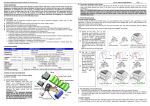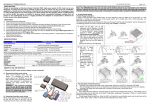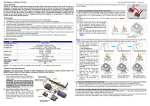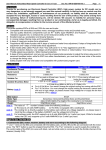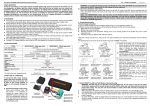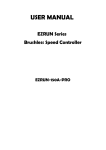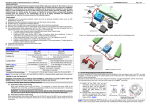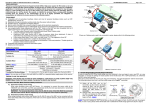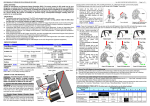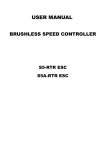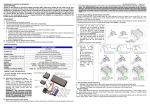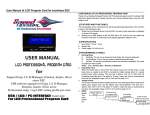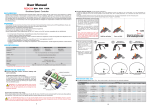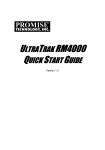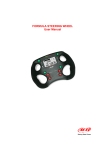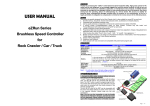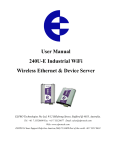Download - Hobbywing
Transcript
User Manual Of XERUN-120A-1S Brushless Speed Controller 【DECLARATION】 Thanks for purchasing our Electronic Speed Controller (ESC). High power system for RC model can be very dangerous, so please read this manual carefully. In that we have no control over the correct use, installation, application, or maintenance of our products, no liability shall be assumed nor accepted for any damages, losses or costs resulting from the use of the product. Any claims arising from the operating, failure of malfunctioning etc. will be denied. We assume no liability for personal injury, consequential damages resulting from our product or our workmanship. As far as is legally permitted, the obligation to compensation is limited to the invoice amount of the affected product. 【FEATURES】 ► Built-in step-up DC/DC converter (DC/DC booster). Perfectly works with 1-2 Lipo cells, so the single cell class racings such as 1/12 scale competitions are easily covered by this XERUN-120A-1S ESC without an additional receiver battery. ► Suitable for 1/10 scale racings by replacing the flat heat sink with the toothed heat sink and cooling fan. ► Compatible with all sensorless brushless motors and most of sensored brushless motors such as LRP, SpeedPassion, Novak, etc. ► Seamlessly change to sensorless working mode when the sensor cable is broken. ► Excellent start-up, acceleration and linearity features. ► Firmware can be updated through an USB adapter on the advanced LCD Program Box (Optional equipment). ► User programmable. Easily programmed with the “SET” button on the ESC and also compatible with the Digital LED Program Card and the advanced professional LCD Program Box. 3 running modes (Forward mode, Forward/Reverse mode, Rock Crawler mode) 4 steps of maximum reverse force adjustment. Proportional ABS brake function with 4 steps of maximum brake force adjustment, 8 steps of drag-brake force adjustment and 4 steps of initial brake force adjustment. 9 start modes (Also called “Punch”) from “very soft (Level 1)” to “very aggressive (Level 9)”. 8 steps of timing adjustment to suitable for all brushless motors. Multiple protection features: Low voltage cut-off protection / Over-heat protection / Throttle signal loss protection / Motor blocked protection. 【SPECIFICATIONS】 Model Cont./ Burst Current Resistance Suitable Car Motor Type Suitable Motor 3-4 NIMH or 1 Lipo 5-6 NIMH or 2 Lipo Battery BEC Output Dimension Weight Fan Working Voltage XERUN-120A-1S 120A / 760A 0.0003 ohm 1/10, 1/12 on-road & off-road car for competition, 1/8, 1/10 rock crawler Sensored and sensorless Brushless Motors ≥2.5T(1/12 on-road) ≥3.5T(1/10 on-road), ≥5.5T(1/10 off-road) 3-6 cells NiMH or 1-2S Li-Po 6V@2A Built-in BEC with step-up DC/DC booster for 1 cell Lipo racing 43mm(L) * 36mm(W) * 33mm(H) 105g [email protected], maximum 8.4V (The fan gets the power supply directly from the battery) 【BEGIN TO USE THE NEW ESC】 HW-SM504ENG-20120702 Page -1- the wires sequence optionally! b) Sensorless brushless motor wiring When using brushless motor without Hall Sensor, the #A, #B, #C wires of the ESC can be connected with the motor wires freely (without any order). If the motor runs in the opposite direction, please swap any two wire connections. Note: For SENSORLESS motor, you can also set the throttle channel of your transmitter to the Reverse” direction, and then the motor will run oppositely. And please calibrate the throttle range again after changing the direction of throttle channel. Please keep in mind that this method is ONLY available for SENSORLESS motor. 2. Throttle Range Setting (Throttle Range Calibration ) In order to make the ESC fit the throttle range, you must calibrate it when you begin to use a new ESC, or a new transmitter, or change the settings such as the neutral position of the throttle stick, ATV or EPA parameters, etc. Otherwise the ESC cannot work properly. There are 3 points need to be set, they are the “Top point of forward”, the “Top point of backward” and the “Neutral point”. The following pictures show how to set the throttle range with a FutabaTM transmitter. A) Switch off the ESC, turn on the transmitter, set the direction of throttle channel to ”REV”, set the throttle trim to “0”, set the “EPA/ATV” value of throttle channel to “100%”, and disable the ABS function of your transmitter. B) Use a pen or screw driver to hold the “SET” key and then switch on the ESC, and release the “SET” key as soon as possible when the red LED begins to flash. (Refer to the picture on the right side) C) Set the 3 points according to the steps shown as the pictures on the right side. ► The neutral point ► The end point of forward direction ► The end point of backward direction D) When the process of calibration is finished, the motor can be started after 3 seconds. 1. Connect the ESC, motor, receiver, battery and servo correctly. a) Sensored brushless motor wiring When using brushless motor with Hall Sensor,it is necessary to connect the sensor cable to the “SENSOR” socket on the ESC, and ESC can automatically identify the motor type (sensored or sensorless) by detecting the signal coming from the SENSOR socket. WARNING! For sensored brushless motor, the #A, #B, #C wires of the ESC MUST be connected with the motor wire #A, #B, #C respectively. Do not change 3. The LED Status In Normal Running ► Normally, if the throttle stick is in the neutral range, neither the red LED nor the green LED lights. ► The red LED lights when the car is running forward or backward and it will flash quickly when the car is braking. ► The green LED lights when the throttle stick is moved to the top point of the forward zone. User Manual Of XERUN-120A-1S Brushless Speed Controller HW-SM504ENG-20120702 【ALERT TONES】 1. Input voltage abnormal alert tone: The ESC begins to check the input voltage when power on, if the voltage is out of the normal range, such an alert tone will be heard: “beep-beep-, beep-beep-, beep-beep-” (There is 1 second interval between every “beep-beep-” tone). 2. Throttle signal abnormal alert tone: When the ESC can’t detect the normal throttle signal, such an alert tone will be heard: “beep-, beep-, beep-” (There is 2 seconds interval between every “beep-” tone). 【PROGRAM THE ESC】 1. Programmable Items List (The italics texts in the form are the default settings) Programmable Items Programmable Value 1 2 3 4 5 6 7 8 9 Basic Items 1. Running Mode Forward with Brake 0% 5% 10% 20% 40% 60% 80% 100% 3.Low Voltage Cut-Off Threshold NonProtection 2.6V/Cell 2.8V/Cell 3.0V /Cell 3.2V /Cell 3.4V /Cell 4.Start Mode(Punch) Level1 Level2 Level3 Level4 Level5 Level6 Level7 Level8 5.Max Brake Force 25% 50% 75% 100% 6.Max Reverse Force 25% 50% 75% 100% 7.Initial Brake Force = Drag Brake Force 0% 20% 40% 8.Neutral Range 6% (Narrow) 9% (Normal) 12% (Wide) 0° 3° 6° 9° 12° 15° 18° 21° 0.00 ° 3.75 ° 7.50 ° 11.25 ° 15.00 ° 18.75 ° 22.50° 26.25° Enable Disable Level9 Advanced Items 9.Boost Timing note1 Timing 10.Over-heat Protection 2.2. Drag Brake Force: Set the amount of drag brake applied at neutral throttle to simulate the slight braking effect of a neutral brushed motor while coasting. 2.3. Low Voltage Cut-Off: The function mainly prevents the lithium battery pack from over discharging. The ESC detects the battery’s voltage at any time, if the voltage is lower than the threshold for 2 seconds, the output power will be reduced 70%, after 10 seconds the output power will be completely shut off and the red LED flashes in such a way: “☆-☆-, ☆-☆-, ☆-☆-”. Please stop your car at the track side as soon as possible to avoid obstructing other racing cars. There are 6 options for this programmable item. You can customize the cutoff threshold by using an advanced LCD Program Box (Optional equipment) to trim it with a step of 0.1V, so it will be more suitable for all kinds of batteries (NiMH, NiCd, Li-ion, Lipo, LFP, etc). 2.5. Maximum Brake Force: The ESC provides proportional brake function. The brake force is related to the position of the throttle stick. Maximum brake force refers to the force when the throttle stick is located at the top point of the backward zone. A very large brake force can shorten the brake time, but it may damage the gears. 2.7. Initial Brake Force: It is also called “minimum brake force”, and it refers to the force when the throttle stick is located at the initial position of the backward zone. The default value is equal to the drag brake force, so the brake effect can be very smoothly. 12.Turbo Timing OFF 1° 2° 3° 4° 5° 6° 7° 8° 13.Boost Start RPM 3000 4500 6000 7500 9000 10500 12000 13500 15000 0s 0.1s 0.2s 0.3s 0.4s 0.5s 0.6s 0.7s 0.8s 15.Timing Punch 200 300 400 550 700 850 1000 (RPM/Degree) th th Note1:When using the firmware with 15 programmable items, the 9 item will be “Boost Timing”. Otherwise the 9 items will be th th “Timing”, and 11 to 15 items are canceled. The factory default firmware is V2.0_100528_MOD (with 15 programmable items). The optional firmware versions are as follows: The ESC firmware with 15 programmable items uses Boost Timing Version Programmable Items Amount and Turbo technology, which is a great innovation for STOCK racing. V2.0_100528_MOD 15 For a standard 11.5T STOCK motor, powered by 2S Lipo battery, when the ESC applies the maximum timing to the motor, it runs at an V2.0_100518STOCK 15 incredible speed more than 110000 RPM, which is much close to the V2.0_100422STOCK 15 speed of a MODIFIED motor (While using traditional technology, such a 11.5T STOCK motor only runs at about 26000RPM). V1.10_090205_MOD 10 But the new technology also has some negative impacts; it brings V1.10_090323a_m 10 more power loss and lower efficiency of the whole system. So it is very V1_508_NO timing 10 important to set the programmable items of your ESC correctly. th Note2:The 11 item is reserved item, with no function. Note3:Please check the manufacturer’s website to get information about the latest software for XERUN-120A-1S ESC. 2. stick from forward zone to backward zone, the car will go backward immediately. This mode is usually used for the Rock Crawler. 2.6. Maximum Reverse Force: Sets how much power will be applied in the reverse direction. Different value makes different reverse speed. 11.Reserved item note2 14.Turbo Delay -2- 2.4. Start Mode (Also called “Punch”): Select from “Level1” to “Level9” as your like, Level1 has a very soft start effect, while level9 has a very aggressive start effect. From Level1 to Level9, the start force is increasing. Please note that if you choose “Level7” to “Level9” mode, you must use good quality battery pack with powerful discharge ability, otherwise these modes cannot get the burst start effect as you want. If the motor cannot run smoothly (the motor is trembling), it may caused by the weak discharge ability of the battery pack, please choose a better battery or increase the gear rate. Forward/Reverse Foward/Reverse with Brake (For Rock Crawler) 2.Drag Brake Force Page Explanation For Each Programmable Item 2.1. Running Mode: With “Forward Only with Brake” mode, the car can go forward and brake, but cannot go backward, this mode is suitable for competition; “Forward/Reverse with Brake” mode provides backward function, which is suitable for daily training. Note: “Forward/Reverse with Brake” mode uses “Double-click” method to make the car go backward. When you move the throttle stick from forward zone to backward zone for the first time (The 1st “click”), the ESC begins to brake the motor, the motor speeds down but it is still running, not completely stopped, so the backward action is NOT happened immediately. When the throttle stick is moved to the backward zone again (The 2nd “click”), if the motor speed is slowed down to zero (i.e. stopped), the backward action will happen. The “Double-Click” method can prevent mistakenly reversing action when the brake function is frequently used in steering. By the way, in the process of braking or reversing, if the throttle stick is moved to forward zone, the motor will run forward at once. “Forward/Reverse” mode uses “Single-click” method to make the car go backward. When you move the throttle 2.8. Throttle Neutral Range: Please refer to the following picture to adjust the neutral range as your like. 2.9. Boost Timing: It is effective throughout the entire throttle range and affects the motor speed in the entire track. Please note this refers to the maximum value of the ESC internal timing, the actual timing is always dynamically changed every moment according to the motor RPM. Timing: The “timing” item is usable for both sensored and sensorless brushless motors. Please select the most suitable timing value according to the motor you are just using. Generally, higher timing value brings out higher power output, but the whole efficiency of the system will be slightly lower down. 2.10. Over-Heat Protection: If the function is activated, the output power will be cut-off when the temperature of the ESC or the internal temperature of the sensored brushless motor is up to a factory-preset value for 5 seconds. When the protection happens, the Green LED will flash. When the ESC is over-heat: The Green LED flashes as “☆-, ☆-, ☆-” (Single flash). When the motor is over-heat: The Green LED flashes as “☆-☆-, ☆-☆-, ☆-☆-” (Double flash). Note: The motor over-heat protection function is only available for the sensored brushless motor made by the same manufacturer of the ESC. For motors made by other manufacturers, this function maybe not available or the protection point doesn’t match the design of the ESC, please disable the over-heat protection function in such a case. 2.11. Reserved item: With no function. 2.12. Turbo Timing: It is the additional timing that added to the Boosting Timing and only effective when the throttle is fully opened, so usually it is useful for long straight track. 2.13. Boost Start RPM: ESC begins to increase the internal timing when motor speed reaches the Boost Start PRM. A lower Boost Start RPM setting will produce a faster rate of boost because the ESC increases the internal timing earlier. 2.14. Turbo Delay: This is the time that must expire at fully opened throttle to engage turbo. If the fully opened time of throttle is less than the setting value, the turbo will NOT be activated. 2.15. Timing Punch: This refers to the RPM increment that triggers the ESC timing increase of 1 Degree. A lower Timing Punch setting will produce a faster acceleration and hotter temperature of the motor. User Manual Of XERUN-120A-1S Brushless Speed Controller HW-SM504ENG-20120702 The different settings of Boost Start RPM and Timing Punch make different internal timing-change curves, which apply different acceleration effect at the motor. We use END PRM to present the motor speed when the presetting timing is fully applied at the motor. END RPM = Boost Start RPM + (Boost Timing + Turbo Timing) * Timing Punch Boost Start RPM Timing Punch Boost Timing Turbo Timing End RPM Example #A 4500 RPM 12° 7° 8300 RPM 200 RPM/° Example #B 6000 RPM 15° 4° 11700 RPM 300 RPM/° Example #A: When motor speed reaches 4500RPM, the ESC begins to increase the internal timing with the step of 1 Degree per 200 RPM increment. Example #B: When motor speed reaches 6000RPM, the ESC begins to increase the internal timing with the step of 1 Degree per 300 RPM increment. Because Example #A uses lower Boost Start RPM and lower Timing Punch settings, it products a faster internal timing increase, that means the motor has a faster acceleration, but the motor will be hotter. SUMMARY 1. To get higher motor speed, please choose higher timing settings. 2. To get faster acceleration, please choose lower Boost Start RPM and lower Timing Punch settings. 3. To get lower motor temperature and long running time, please choose lower timing, higher Boost Start RPM and higher Timing Punch settings. SUGGESTED SETTINGS The following settings are suitable for 1/10 scale on-road touring cars, and the motor has an initial mechanical timing (also called: Endbell timing) of 0 to 5 Degree. Motor Final Gear Rate #9 Boost Timing #12 Turbo Timing 11.5T 13.5T 17.5T 6.0-6.5 6.5-7.0 6.0-6.5 Option 6 Option 8 Option 8 Option 7 Option 7 Option 9 #13 Boost Start RPM Option 5 Option 3 Option 1 #14 Turbo Delay #15 Timing Punch Option 5 Option 5 Option 5 Option 5 Option 2 Option 1 3. Reset All Items To Default Values At any time when the throttle is located in neutral zone (except in the throttle calibration or parameters program process), hold the “SET” key for over 3 seconds, the red LED and green LED will flash at the same time , which means each programmable item has be reset to its default value. 【BRUSHLESS SYSTEM CONFIGURATION SUGGESTION】 Motor KV/ Power Gear Rate Gear Rate On Road 1/10 Off Road 3.5T 9100KV/600W 4.5T 7300KV/500W 3.5T 9100KV/600W 9.6-11.0(1/10) 4.5T 7300KV/500W 8.4-10.0(1/10) 5.5T 6000KV/400W 8.0-9.4(1/10) 10.0-12.0 6.5T 5200KV/350W 7.4-8.4(1/10) 9.0-11.0 8.5T 4000KV/300W 6.0-7.0(1/10) 8.0-9.6 10.5T 3300KV/250W 5.0-6.0(1/10) 7.5-8.5 13.5T 2700KV/200W 4.5-5.5(1/10) 7.0-8.0 17.5T 1900KV/150W Suitable ESC 120A-1S with 1S Lipo 4.5-5.5(1/10) 6.0-8.0 Application -3- 【TROUBLE SHOOTING】 Trouble Possible Reason Solution After power on, motor doesn ’ t work, no The connections of battery pack Check the power connections, replace the sound is emitted are not correct connectors or switch The switch is damaged After power on, motor can ’ t work, but Input voltage is abnormal, too high Check the voltage of the battery pack emits “ beep-beep-, beep-beep- ” alert or too low. tone. (Every “ beep-beep- ” has a time interval of 1 second ) After power on, the red LED lights, but Throttle signal is abnormal Check the transmitter and the receiver, and motor cannot run check the signal wire connection of your ESC The motor runs in the opposite direction 1) The wire connections between 1) Swap any two wire connections between the the ESC and the motor need to be ESC and the motor. (Note: This method is changed ONLY available for SENSORLESS motor ) 2) The chassis is not suitable for 2) Please don't use the ESC for this special chassis. this ESC The motor stops running while in working The ESC has entered the “ Low The red LED flashes means Low voltage state voltage protection mode ” or the “ protection, please replace the battery pack Over-heat protection mode” The green LED flashes means Over-heat protection, please stop running to cool the ESC When accelerating quickly, the motor 1) The battery has a bad 1) Use a better battery stops or trembles discharge performance 2) Gear rate is too aggressive so 2) Use lower KV motor or change the gear rate the motor load is too heavy or set the "Start Mode" more softly When the throttle stick is in the neutral The motor is a sensored motor, 1) Check the connection of Hall sensor cable to range, the red LED and the green LED but the ESC detects abnormal make it firmly connecting the motor with the flashes synchronously signal from the sensor, so it ESC changes to sensorless mode 2) The Hall sensors in the motor are damaged, automatically please change the motor The motor trembles but cannot start 1) The connctions are not A-A, B- 1) Check the connections smoothly B and C-C 2) The ESC is damaged 2)Contact the dealer for after-sales service 【PROGRAM THE ESC】 1. Program the ESC with LED program box (Optional equipment ) Please refer to the user manual of LED program box. 1/12 On-road competitive racing (Modified group) 2. Program the ESC with advanced LCD program box (Optional equipment ) Please refer to the user manual of LCD program box. 1/10 On-road competitive racing (Modified group) 3. Program the ESC with the SET button on the ESC Please refer to the instructions as follow. (This function will be invalid when using the firmware with 15 programmable items) 1/10 On-Road sportful racing 1/10 Off-road competitive racing (Modified group) 120A-1S with 2S Lipo Page 1/10, 1/12 On-Road normal racing (Stock group) 1/10, 1/12 Off-Road normal racing (Stock group) 1/10, 1/12 On-Road and Off-Road normal racing (Stock group) 1/10 Crawler Note: The “Power of motor” means the maximum output power under 7.2V. The “Gear rate” is just the recommended value for 1/10 scale car/truck under 6 cells NiMH battery input. User Manual Of XERUN-120A-1S Brushless Speed Controller Note: ► In the program process, the motor will emit “Beep” tone at the same time when the LED is flashing. ► If the “N” is bigger than the number “5”, we use a long time flash and long “Beep---” tone to represent “5”, so it is easy to identify the items of the big number. For example, if the LED flashes as the following: “A long time flash + a short time flash” (Motor sounds “Beep---Beep”) = the No. 6 item “A long time flash + 2 short time flash” (Motor sounds “Beep---BeepBeep”) = the No. 7 item “A long time flash + 3 short time flash” (Motor sounds “Beep---BeepBeepBeep”) = the No. 8 item And so on. HW-SM504ENG-20120702 Page -4-




